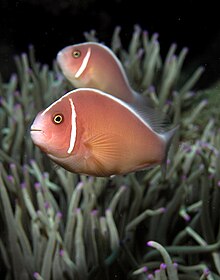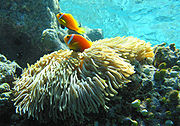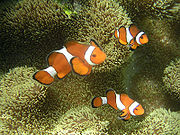Clownfish
| Clownfish | |
|---|---|

| |
| Ocellaris clownfish, Amphiprion ocellaris | |
| Scientific classification | |
| Kingdom: | |
| Phylum: | |
| Class: | |
| Order: | |
| Family: | |
| Subfamily: | Amphiprioninae
|
| Genera | |



Clownfish or anemonefish are fishes from the subfamily Amphiprioninae in the family Pomacentridae. Thirty species are recognized, one in the genus Premnas, while the remaining are in the genus Amphiprion. In the wild they all form symbiotic mutualisms with sea anemones. Depending on species, clownfish are overall yellow, orange, reddish or blackish, and many show white bars or patches. The largest can reach a length of 18 centimetres (7.1 in), while the smallest barely can reach 10 centimetres (3.9 in).
Ecology and habitat
Clownfish are native to warmer waters of the Indian and Pacific oceans, including the Great Barrier Reef and the Red Sea. While most species have restricted distributions, others are widespread. Clownfish live at the bottom of shallow seas in sheltered reefs or in shallow lagoons. There are no clownfish in the Atlantic.
Diet
Clownfish feed on small invertebrates which otherwise potentially could harm the sea anemone, and the fecal matter from the clownfish provides nutrients to the sea anemone. Clownfish are omnivorous: in the wild they eat live food such as algae, plankton, mollusks, and crustacea; in captivity they can survive on live food, fish flakes, and fish pellets. Algae accounts for around 20 to 25 percent of its diet in the wild (and should also account for its amount of algae diet in captivity as well). The diet of the clownfish also consists of copepods, mysids, isopods, zooplankton and undigested food from their host anemones.[1]
Symbiosis and mutualism
Clownfish and sea anemones have a symbiotic, mutualistic relationship, each providing a number of benefits to the other. The individual species are generally highly host specific, and especially the genera Heteractis and Stichodactyla, and the species Entacmaea quadricolor are frequent clownfish partners. The sea anemone protects the clownfish from predators, as well as providing food through the scraps left from the anemone's meals. In return, the clownfish defends the anemone from its predators, and cleans it from parasites.[2][3] The anemone also potentially picks up nutrients from the clownfish's excrement, and functions as a safe nest site.[4] It has been theorized that the clownfish use their bright colouring to lure small fish to the anemone,[5] and that the activity of the clownfish results in greater water circulation around the sea anemone.[citation needed]
Clownfish and certain damselfish are the only species of fishes that can avoid the potent poison of a sea anemone. There are several theories about how they can survive the sea anemone poison:
- The mucus coating of the fish may be based on sugars rather than proteins. This would mean that anemones fail to recognize the fish as a potential food source and do not fire their nematocysts, or sting organelles.
- The coevolution of certain species of clownfish with specific anemone host species and may have acquired an immunity to the nematocysts and toxins of their host anemone. Experimentation has shown that Amphiprion percula may develop resistance to the toxin from Heteractis magnifica, but it is not totally protected, since it was shown experimentally to die when its skin, devoid of mucus, was exposed to the nematocysts of its host.[6]
Reproduction
In a group of clownfish, there is a strict dominance hierarchy. The largest and most aggressive female is found at the top. Only two clownfish, a male and a female, in a group reproduce through external fertilization. Clownfish are sequential hermaphrodites, meaning that they develop into males first, and when they mature, they become females. If the female clownfish is removed from the group, such as by death, one of the largest and most dominant males will become a female. The remaining males will move up a rank in the hierarchy.
Clownfish lay eggs on any flat surface close to their host anemones. In the wild, clownfish spawn around the time of the full moon. Depending on the species, clownfish can lay hundreds or thousands of eggs. The male parent guards the eggs until they hatch about 6 to 10 days later, typically 2 hours after dusk.[citation needed]
In the aquarium
This section contains instructions, advice, or how-to content. (May 2011) |
Clownfish were the first type of marine ornamental fish to be successfully bred in captivity on a large scale.[citation needed] It is one of a handful of marine ornamentals whose complete life cycle has been closed in captivity. Members of some clownfish species, such as the maroon clownfish, become aggressive in captivity; others, like the false percula clownfish, can be kept successfully with other individuals of the same species.[citation needed]
Clownfish are now reared in captivity by a handful of marine ornamental farms in the USA. Clownfish were the first species of Saltwater fish to successfully be Tank-raised. Tank-raised fish are a better choice for aquarist, because wild-caught fish are more likely to die soon after purchasing them due to the stress of capture and shipping. Also, tank-bred fish are usually more disease resistant and in general are less affected by stress when introduced to the aquarium. Captive bred clownfishes may not have the same instinctual behavior to live in an anemone. They may have to be coaxed into finding the anemone by the home aquarist. Even then, there is no guarantee that the anemone will host the clownfish.
When a sea anemone is not available in an aquarium, the clownfish may settle in some varieties of soft corals, or large polyp stony corals. If the fish settles in a coral, it could agitate the fish's skin, and, in some cases, may kill the coral. Once an anemone or coral has been adopted, the clownfish will defend it. As there is less pressure to forage for food in an aquarium, it is common for clownfish to remain within 2-4 inches of their host for an entire lifetime.
Taxonomy
- Genus Amphiprion:[7]
- Amphiprion akallopisos – Skunk clownfish
- Amphiprion akindynos – Barrier Reef Anemonefish
- Amphiprion allardi – Twobar anemonefish
- Amphiprion barberi
- Amphiprion bicinctus – Twoband anemonefish
- Amphiprion chagosensis – Chagos anemonefish
- Amphiprion chrysogaster – Mauritian anemonefish
- Amphiprion chrysopterus – Orange-fin anemonefish
- Amphiprion clarkii – Yellowtail clownfish
- Amphiprion ephippium – Saddle anemonefish
- Amphiprion frenatus – Tomato clownfish
- Amphiprion fuscocaudatus – Seychelles anemonefish
- Amphiprion latezonatus – Wide-band Anemonefish
- Amphiprion latifasciatus – Madagascar anemonefish
- Amphiprion leucokranos – Whitebonnet anemonefish
- Amphiprion mccullochi – Whitesnout anemonefish
- Amphiprion melanopus – Fire clownfish
- Amphiprion nigripes – Maldive anemonefish
- Amphiprion ocellaris – Clown anemonefish
- Amphiprion omanensis – Oman anemonefish
- Amphiprion pacificus – Pacific anemonefish
- Amphiprion percula – Orange clownfish
- Amphiprion perideraion – Pink skunk clownfish
- Amphiprion polymnus – Saddleback clownfish
- Amphiprion rubacinctus – Red Anemonefish
- Amphiprion sandaracinos – Yellow clownfish
- Amphiprion sebae – Sebae anemonefish
- Amphiprion thiellei – Thielle's anemonefish
- Amphiprion tricinctus – Three-band anemonefish
- Genus Premnas:[8]
- Premnas biaculeatus – Maroon clownfish
In popular culture
In the 2003 animated film Finding Nemo, the main character is a clownfish. The film told the story of a young clownfish called Nemo, who goes missing and his father Marlin, also a clownfish, goes on an adventure to get him back. Along the way they meet several other aquatic life forms. The species depicted in the film is A. ocellaris.[2]
Gallery
-
Allard's clownfish (Amphiprion allardi).
-
Maldive anemonefish (Amphiprion nigripes). It is sometimes called the Black-finned anemonefish due to its black pelvic and anal fins.
-
Pink skunk clownfish (Amphiprion perideraion).
-
Yellow clownfish (Amphiprion sandaracinos) and sea anemone off Sulawesi, Indonesia.
-
Yellowtail clownfish (Amphiprion clarkii) with sea anemone.
-
Orange-fin anemonefish (Amphiprion chrysopterus) is one of the few anemonefish with a white tail.
-
Twoband anemonefish (Amphiprion bicinctus). It is, as suggested by its alternative common name Red Sea clownfish, almost entirely restricted to the Red Sea.
-
Clown anemonefish (Amphiprion ocellaris) occurs in a 'normal' orange and a melanistic blackish variant. The exact taxonomic status of the latter is unclear.
-
Fire clownfish (Amphiprion melanopus) and sea anemone at the Great Barrier Reef.
-
Maroon clownfish (Premnas biaculeatus), here with a tang, is the only member of the genus Premnas, and the largest species of clownfish.
-
Clownfish are initially male; the most dominant fish in a group becomes female.
References
- ^ http://tolweb.org/treehouses/?treehouse_id=3390
- ^ a b "Clown Anemonefish". Nat Geo Wild : Animals. National Geographic Society. Retrieved 2011-12-19.
- ^ "Clownfish" at the Encyclopedia of Life
- ^ Holbrook, S. J. and Schmitt,R. J. Growth, reproduction and survival of a tropical sea anemone (Actiniaria): benefits of hosting anemonefish, 2005, cited in [1]
- ^ "Clown Anemonefishes, Amphiprion ocellaris". Marinebio. The MarineBio Conservation Society. Retrieved 2011-12-19.
- ^ Mebs, D. 1994. "Anemonefish symbiosis: Vulnerability and Resistance of Fish to the Toxin of the Sea Anemone.” Toxicon. Vol. 32(9):1059-1068.
- ^ Froese, Rainer and Pauly, Daniel, eds. (2011). Species of Amphiprion in FishBase. December 2011 version.
- ^ Froese, Rainer and Pauly, Daniel, eds. (2011). Species of Premnas in FishBase. December 2011 version.












